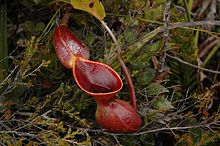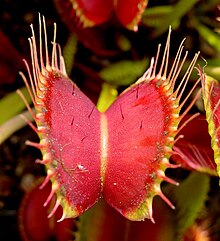Bimët mishngrënëse
Bimët mishngrënëse janë bimë që nxjerrin disa ose shumicën e lëndëve ushqyese të tyre nga kapja dhe konsumimi i kafshëve ose protozoarëve, zakonisht insektet dhe artropodët e tjerë, dhe herë pas here gjitarët dhe zogjtë e vegjël. Ata ende gjenerojnë të gjithë energjinë e tyre nga fotosinteza . Ato janë përshtatur të rriten në vende ku toka është e varfër në lëndë ushqyese, veçanërisht azot.[4] Ato mund të gjenden në të gjitha kontinentet, përveç Antarktidës, si dhe shumë ishuj të Paqësorit. [5]

Në 1875, Charles Darwin botoi Bimët Insektivore, traktatin e parë që njohu rëndësinë e mishngrënësit në bimë, duke përshkruar vite të tëra kërkimesh të mundimshme. [6] [4]
Mishngrënia e vërtetë besohet se ka evoluar në mënyrë të pavarur të paktën 12 herë [6] [7] [8] [9] [10] në pesë rende të ndryshme të bimëve të lulëzuara, [11] [12] dhe përfaqësohet nga më shumë se një dyzinë gjini . Ky klasifikim përfshin të paktën 583 lloje që tërheqin, kapin dhe vrasin gjahun, duke thithur lëndët ushqyese të disponueshme që rezultojnë. [13] [14] Kurthi i mizave të Venusit ( Dionaea muscipula ), bima e shtambës ( Cephalotus follicularis ) dhe fshikëza ( Utricularia gibba ) mund të shihen si shembuj të tipareve kryesore të lidhura gjenetikisht me mishngrënësit: zhvillimi i gjetheve të kurthit, tretja e gjahut dhe thithja e lëndëve ushqyese. [11]


- ^ Clarke CM, Bauer U, Lee CC, Tuen AA, Rembold K, Moran JA (tetor 2009). "Tree shrew lavatories: a novel nitrogen sequestration strategy in a tropical pitcher plant". Biology Letters. 5 (5): 632–5. doi:10.1098/rsbl.2009.0311. PMC 2781956. PMID 19515656.
{{cite journal}}: Mungon ose është bosh parametri|language=(Ndihmë!) - ^ Chin L, Moran JA, Clarke C (prill 2010). "Trap geometry in three giant montane pitcher plant species from Borneo is a function of tree shrew body size". The New Phytologist. 186 (2): 461–70. doi:10.1111/j.1469-8137.2009.03166.x. PMID 20100203.
{{cite journal}}: Mungon ose është bosh parametri|language=(Ndihmë!) - ^ Clarke C, Moran JA, Chin L (tetor 2010). "Mutualism between tree shrews and pitcher plants: perspectives and avenues for future research". Plant Signaling & Behavior. 5 (10): 1187–9. doi:10.4161/psb.5.10.12807. PMC 3115346. PMID 20861680.
{{cite journal}}: Mungon ose është bosh parametri|language=(Ndihmë!) - ^ a b Darwin, Charles (1875). Insectivorous Plants. London: John Murray. Marrë më 14 mars 2022.
{{cite book}}: Mungon ose është bosh parametri|language=(Ndihmë!) - ^ Cross, A. T. (2019). "Carnivorous plants.". A Jewel in the Crown of a Global Biodiversity Hotspot. Perth: Kwongan Foundation and the Western Australian Naturalists' Club Inc.
{{cite book}}: Mungon ose është bosh parametri|language=(Ndihmë!) - ^ a b Pain, Stephanie (2 mars 2022). "How plants turned predator". Knowable Magazine. doi:10.1146/knowable-030122-1. Marrë më 11 mars 2022.
{{cite journal}}: Mungon ose është bosh parametri|language=(Ndihmë!) Gabim referencash: Invalid<ref>tag; name "Pain" defined multiple times with different content - ^ Kauffmann, Michael (9 gusht 2021). "Cryptic Carnivores". Backcountry Press. Marrë më 11 mars 2022.
{{cite news}}: Mungon ose është bosh parametri|language=(Ndihmë!) - ^ Callaway, Ewen (6 shkurt 2017). "How plants evolved into carnivores: Distantly related plants acquired their ability to eat meat through similar genetic changes". Nature (në anglisht). 542 (7640). doi:10.1038/nature.2017.21425. eISSN 1476-4687. ISSN 0028-0836.
'We're really looking at a classic case of convergent evolution,' says Victor Albert, a plant-genome scientist....
- ^ "The long reach of the monster plant: Carnivorous plants have fascinated writers and botanists alike". Nature (në anglisht). 542 (7640): 138. 6 shkurt 2017. Bibcode:2017Natur.542R.138.. doi:10.1038/542138b. eISSN 1476-4687. ISSN 0028-0836. PMID 28179680.
- ^ Lin, Qianshi; Ané, Cécile; Givnish, Thomas J.; Graham, Sean W. (9 gusht 2021). "A new carnivorous plant lineage (Triantha) with a unique sticky-inflorescence trap". Proceedings of the National Academy of Sciences. 118 (33). Bibcode:2021PNAS..11822724L. doi:10.1073/pnas.2022724118. ISSN 0027-8424. PMC 8379919. PMID 34373325.
{{cite journal}}: Mungon ose është bosh parametri|language=(Ndihmë!) - ^ a b Hedrich, Rainer; Fukushima, Kenji (17 qershor 2021). "On the Origin of Carnivory: Molecular Physiology and Evolution of Plants on an Animal Diet". Annual Review of Plant Biology. 72 (1): 133–153. doi:10.1146/annurev-arplant-080620-010429. ISSN 1543-5008. PMID 33434053. Marrë më 11 mars 2022.
{{cite journal}}: Mungon ose është bosh parametri|language=(Ndihmë!) - ^ Ellison AM, Gotelli NJ (2009). "Energetics and the evolution of carnivorous plants—Darwin's 'most wonderful plants in the world'". Journal of Experimental Botany. 60 (1): 19–42. doi:10.1093/jxb/ern179. PMID 19213724.
{{cite journal}}: Mungon ose është bosh parametri|language=(Ndihmë!) - ^ Givnish TJ (janar 2015). "New evidence on the origin of carnivorous plants". Proceedings of the National Academy of Sciences of the United States of America. 112 (1): 10–1. Bibcode:2015PNAS..112...10G. doi:10.1073/pnas.1422278112. PMC 4291624. PMID 25538295.
{{cite journal}}: Mungon ose është bosh parametri|language=(Ndihmë!) - ^ Barthlott W, Porembski S, Seine R, Theisen T (2007). The Curious World of Carnivorous Plants: A Comprehensive Guide to Their Biology and Cultivation. Përkthyer nga Ashdown M. Portland: Timber Press. ISBN 9780881927924.
{{cite book}}: Mungon ose është bosh parametri|language=(Ndihmë!)